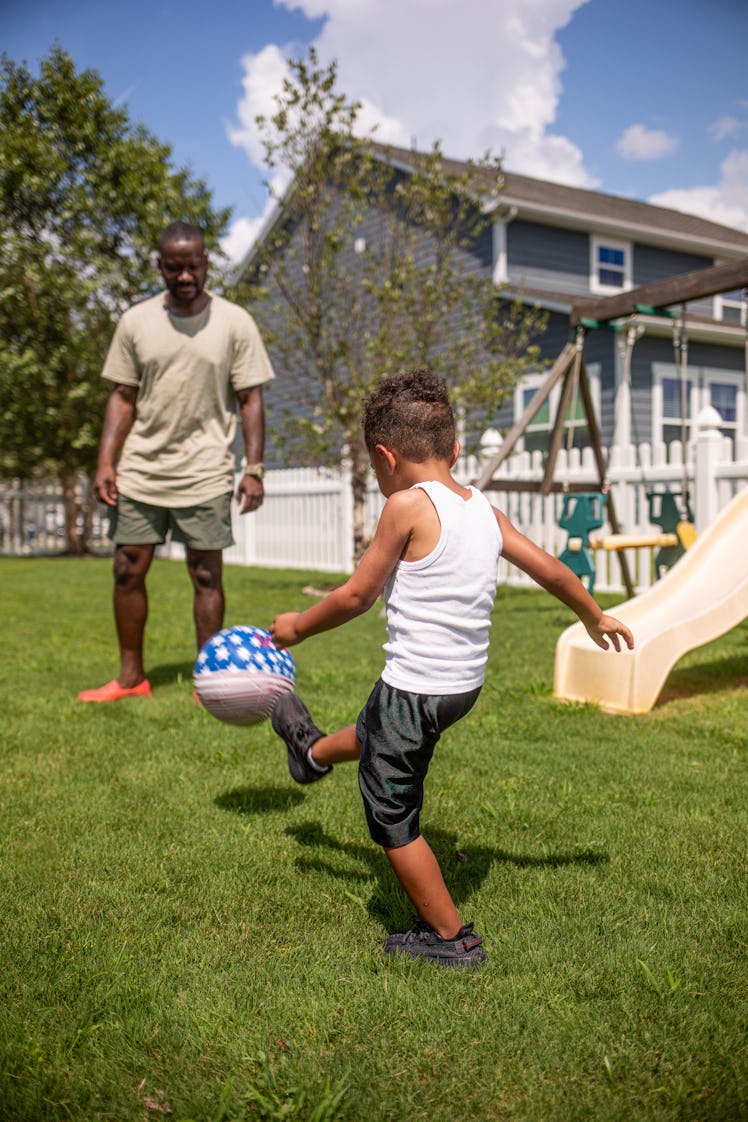The Trick To Teaching Your Kid To Kick A Soccer Ball
Four lessons to start a young soccer player off right.

Soccer is the second most-popular youth sport in the United States (trailing only basketball). And with a young American team showing us what they have in the 2022 World Cup, soccer is likely to get more and more popular, recruiting the kids who no longer play football. To that end — and given America’s lackluster coaching talent — parents would do well to know the fundamentals and, very specifically, how to kick a ball. That sounds basic, but many adults do it wrong. So we asked Yael Averbuch, a US Women’s National Team veteran and player for Seattle Reign FC, for a little bit of guidance.
Averbuch’s started playing soccer as a kid because it was a fun way to bond with her best friend. “I started playing soccer when I was seven because my best friend in school played,” Averbuch laughs. “Neither of my parents played soccer so we all learned the sport together. I remember saying I wanted to be a professional soccer player when I was nine but I had no idea what that meant.”
If your child comes to you, wanting to play the world’s most popular sport, you better take a cue from Averbuch’s parents and learn how to play quickly. Luckily, we asked her for her top tips for getting your child from the early stages of kicking a ball to what they should work on to become the stars of their peewee soccer teams.
Lesson #1: Side Foot vs. Laces
The first question most soccer players will run into is deceptively complex: How do you kick a soccer ball? Sure, you can run up to it and whack it with a toe poke, but if you want to do it right, you have to have foot control. “I think it’s important to remember that ‘kicking’ includes a variety of techniques, depending on the purpose,” said Averbuch. “The two types of basic kicks are the inside of the foot pass, which is used to pass to a teammate, and the laces drive, which is normally used to shoot the ball.”
As most players won’t be the ones taking every shot (cough, Cristiano Ronaldo, cough) the inside of the foot is key development; if you can pass the ball around, you’re ahead of the game. “You want to make sure the ankle of your kicking foot is locked and not floppy and that your plant foot–your non-kicking foot–is facing towards where you want to pass,” said Averbuch, who is known for her passing aptitude. “You should flex your foot and rotate it outwards so the flat surface of the inside of the foot can connect with the ball.”
Of course, sometimes, you just want to let it rip.
“For a laces drive, you want to point your toe down and, again, lock your ankle so your foot doesn’t flop around as you connect with the ball,” says Averbuch. Sure, there are other types of shots (the chip shot, a side-foot finesse shot, the incredible-looking-when-it-works outside of the foot curler), but mastering the simple laces shot should be high on the priority list.
Lesson #2: Seriously, Lock That Ankle!
When asked what the most common mistake that new players make on a regular basis, Averbuch had one answer: Mind your ankle!
“The most common mistake is to not lock the ankle! This will make kicking not as effective, and also it can hurt to kick if your ankle is floppy.” There has been plenty written about the importance of the ankle in soccer, and yet, a floppy ankle can make your kid’s skills take a nosedive. If the foot isn’t as solid as possible when kicking, the ball will come out with less force, making passes easier to intercept and shots easier to save. Not to mention, it could cause injury to your child as they overwork their ankle unnecessarily.
Lesson #3: Both Feet Are Important
You may think that the beginning stages of a kid’s learning are just about getting them to kick the ball at all, but Averbuch thinks it’s important to get them to do one simple thing: use both feet. “I think it’s important for players to practice kicking with both feet right from the start,” she said. “Most players will automatically have a foot that is more natural to use, but the more practice that can be done with both, the easier it will be to use both feet down the line as players get more advanced.”
Lesson #4: Passing Beats Shooting
Your kid might get super excited after learning to kick, and they will want to go for glory and shoot on goal until the cows come home. While fun is, of course, a major part of why you want to teach your kid to play, Averbuch has one tip for putting them on the right path: prioritize passing.
“The single most important thing is to not try to kick far and hard before you’ve mastered the correct technique on shorter, softer passes,” she said. “A lot of power and being able to kick far is not about strength, but instead technique.” So, before telling your little striker-in-training to try free kicks, teach them to pass the ball. This will also help them make friends.
This article was originally published on